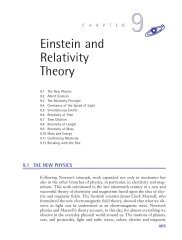Chapter 12: Electromagnetic Waves (545 KB) - D Cassidy Books
Chapter 12: Electromagnetic Waves (545 KB) - D Cassidy Books
Chapter 12: Electromagnetic Waves (545 KB) - D Cassidy Books
You also want an ePaper? Increase the reach of your titles
YUMPU automatically turns print PDFs into web optimized ePapers that Google loves.
3637_<strong>Cassidy</strong>TX_<strong>12</strong> 6/13/02 11:34 AM Page 568■ TELEVISION (Continued)ing glass close to a television screen, you willprobably be able to see the individual pixelsthat make up the image.Through this process, a television setcomposes rapidly one still image after anotheron the screen at the rate of at least 15images, or frames, per second, which yourbrain perceives as a fluid moving scene.ThesubjectLensMotorNipkow diskLensLightsensorTELEVISION: THE INVENTIONThe research and development of televisiontechnology happened along two paths, mechanicaland electronic.FIGURE <strong>12</strong>.13 Diagram of Nipkow disk apparatus.Mechanical TelevisionTelevision was inspired by human vision, inwhich thousands upon thousands of electricalcircuits are used to relay information inthe optic nerve from the retina to the brain.Designs based on so many electrical circuits,however, were far too complicated to everreach fruition. In 1880 Maurice Leblanc inFrance and W.E. Sawyer in the United Statessuggested instead that if each element of apicture could be rapidly scanned, electricaltransmission of pictures could be achievedusing only one circuit between the transmitterand receiver. Paul Nipkow of Germanyadopted this scanning technique in 1884.The picture to be televised is focused on arotating disk. When the first aperture in thedisk has scanned a line of the picture, the nextaperture scans the parallel line directly below.At each rotation of the disk another line isscanned until the whole picture has been examined.In this design, more apertures meanmore lines, and hence greater detail of thepicture. As it passes through each aperture,the light differs according to the light andshade of the picture, it then passes through aphotoelectric cell where it is changed into anelectrical image, and then translated into electricalimpulses. These impulses are then sentdown a circuit to a receiver, where they producelight in something like a gas-dischargelamp. The light from this lamp is then projectedonto another disk, similar to the transmitter,and by a reversal of the transmissionprocess, the brightness of each segment is reproducedand the original picture is reconstructed.In order for this system to work, therotation of the disks must be synchronized,and provided they are rotating at a sufficientspeed, persistence of vision allows the observerto see a whole image rather than a seriesof moving segments.Until the arrival of electronic scanning, itwas this mechanical system, characterized bythe Nipkow disk, which dominated the developmentof television. However, the systemwas crude, with the small number of lines resultingin poor definition and the small numberof rotations causing a flicker. Thereforeresearch turned toward electronic systems.Electronic SystemsOne of the leading players in the developmentof electronic television was VladimirKosma Zworykin. He was convinced thatelectronic television was the path he shouldfollow, and while working for the Radio Corporationof America (RCA), he developed theIconoscope which used a CRT for transmittingimages.At the wide end of the Ionoscope is a sheetof mica, on one side of which is a signal plate,and the other a silver mosaic treated with568






